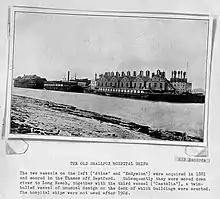Long Reach, Kent
Long Reach is a low-lying area north of Dartford, Kent, in southeast England, on the south side of the River Thames, east of Erith and the River Darent. It was the site of a pub (the Long Reach Tavern), a fireworks factory, a smallpox hospital and, from 1911, a Vickers airfield that later became RAF Joyce Green. It also gives its name to a Thames Water sewage treatment works.
| Long Reach | |
|---|---|
 Long Reach Location within Kent | |
| District | |
| Shire county | |
| Region | |
| Country | England |
| Sovereign state | United Kingdom |
| Post town | DARTFORD |
| Postcode district | DA1 |
| Dialling code | 01322 |
| Police | Kent |
| Fire | Kent |
| Ambulance | South East Coast |
| UK Parliament | |
The area is named after the Long Reach (a name given to the longest straight stretch of a river), the stretch of the Thames between St Clement's Reach and Erith Rands.[1]
Landmarks
Long Reach Tavern (c. 1800s-1957)

The Long Reach Tavern was a riverside pub that had a jetty extending into the Thames, enabling its use by barge and tugboat crews.[2] It was recorded as a tied house of the Fleet Brewery in 1865, and in 1866 hosted a bare-knuckle boxing championship match between James Mace and Joseph Goss.[2] Damaged by the North Sea flood of 1953, it was demolished in 1957 to allow construction of new flood embankments.[2]
Long Reach Hospital

Despite some local opposition, in May 1881, the Metropolitan Asylum Board (MAB) established a temporary tented camp for smallpox patients on land it owned north of Dartford.[3] In 1883, it purchased further land for smallpox camp purposes, including Gore Farm and a strip of land previously owned by the Church Commissioners called Long Reach.[3] Further hospital accommodation was then found aboard two ships initially chartered and later purchased from the Admiralty: the Atlas and the Endymion. A paddle-steamer, Castalia, was later added, with all three moored in the Thames adjacent to Long Reach.[3][4] Together the three hospital ships provided 350 patient beds, plus administration, stores and staff quarters.[5] Onshore facilities included a laundry, additional nurses accommodation, and an electricity generation building. A pier was constructed so that patients could be brought from London by river ambulance.[3] A permanent convalescent hospital was provided at Gore farm in 1890, and in 1901, Long Reach Hospital was built, followed by the Orchard Hospital. Finally, in 1903, a permanent smallpox hospital – Joyce Green Hospital – opened, and the ships were sold for scrap in 1904.[3][5]
The permanent Long Reach hospital had 300 beds and admitted its first patients in February 1902.[6] It was retained as a reserve hospital for smallpox patients, and was rebuilt in 1928. In February 1953, the hospital was flooded, but was able to reopen just over a month later. It hosted its last patient in 1973, and in 1974 was demolished to make way for improved flood defences.[6][7]
RAF Joyce Green
Joyce Green was one of the first Royal Flying Corps (RFC) airfields. It was established in 1911 by Vickers Limited (the aircraft and weapons manufacturer, who had a factory at nearby Erith) who used it as an airfield and testing ground. At the outbreak of World War I in 1914, the RFC followed and established a base. Subject to frequent flooding and with a reputation as being unsuitable and too dangerous for training, it was eventually replaced by a more suitable site at RAF Biggin Hill.
Wells fireworks factory
The Wells Fireworks factory was built in the early 1950s, for a business originally established by Joseph Wells, an explosive lighter man, in Dartford in 1837.[8] The 1953 flood caused an explosion at the factory. It closed in the 1970s.[9]
Long Reach STW
Long Reach sewage treatment works (STW), located on the south bank of the River Thames at 51.4673°N 0.2365°E, is operated by Thames Water. As of 2012, the plant was capable of treating 346 million litres of sewage per day. It treats wastewater from a catchment area of 518 square kilometres (200 sq mi), covering Bexley, Bromley, Croydon, Dartford, Sevenoaks, Tandridge, and from Tonbridge and Malling. It serves a population of over 800,000 people.[10][11] It is adjacent to the site of the former Littlebrook Power Station.
References
- "Reaches of the River Thames". On the Thames. Retrieved 5 November 2021.
- "Long Reach Tavern". Dover Kent Archives: Pub List. Retrieved 5 November 2021.
- "Hospital Ships: Introduction". Dartford Hospital Stories. Retrieved 5 November 2021.
- "The Long Reach Hospital Ships - Ghosts of the Dartford Marshes". Remote London. Retrieved 5 November 2021.
- "Smallpox Hospital Ships in London". Historic UK. Retrieved 5 November 2021.
- "Long Reach: Introduction". Dartford Hospital Stories. Retrieved 5 November 2021.
- "Long Reach Hospital, Dartford". The Workhouse. Retrieved 5 November 2021.
- "History". Wells Fireworks. Retrieved 5 November 2021.
- "The Wells Fireworks factory - disused & overgrown - the Dartford Marshes". Remote London. Retrieved 5 November 2021.
- David Hilton (2011). "Long Reach STW" (PDF). UK Water Projects. Retrieved 28 June 2023.
- "Long Reach Sewage Treatment Works – Sewage Works Upgrades". Thames Water. 27 August 2012. Archived from the original on 18 September 2012. Retrieved 23 March 2013.